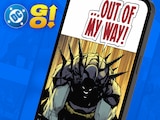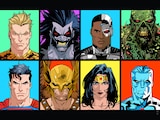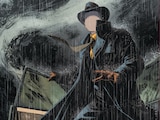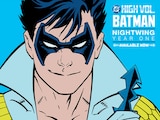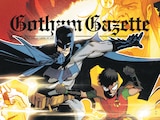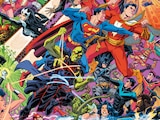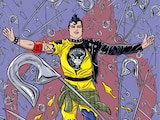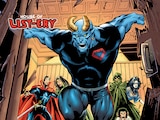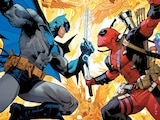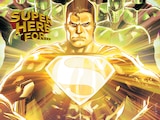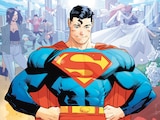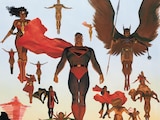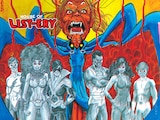These days, there's a good chance when you hear the name Oliver Queen, you'll probably imagine a live-action TV show character—which makes a lot of sense! The Arrowverse catapulted Green Arrow from relative obscurity into the spotlight and kept him there for years. But did you know that the character's comic book origins extend all the way back to the 1940s? While some critical components have remained the same over the decades, the Green Arrow we know and love today has traveled a long, long way to get here. Let's take a look at the evolution and growth of the Emerald Archer.

Golden Age Origins
Strangely enough, Ollie's backstory is one of the things that hasn't actually changed all that much. Back in the '40s, he was introduced as, well, pretty much an exact clone of Batman, only green and with a focus on archery. Ollie was a wealthy capitalist who, through a series of unfortunate events, wound up stranded on a deserted island with only a bow and arrow around to fend for himself. The traumatic events did two things: Made him an absolutely incredible archer and gave him an unquenchable need for vengeance that inspired him to become a superhero. It's not quite seeing your parents murdered in Crime Alley, but it's close—and, hey, if you've got the extra money lying around to spend on gizmos and gadgets, why not, right?
The critical thing to understand here was that in the Golden Age, the idea of "secret origins" and "continuity" really hadn't solidified into what we know them as today. In these early days, Oliver and Bruce had no chance of running into one another, so it didn't matter that one was clearly riffing off the other—they were both accomplishing their intended goals in their intended stories. Oliver even got his own version of Robin, a kid sidekick called Speedy, and wound up getting equipped with Arrow-branded accessories like an Arrow Car, which ultimately helped him survive the growing pains of the comics industry as a whole.

Reinvention
The Silver Age, as some of you doubtlessly already know, was a wild time for comics and characters both. It's an era largely defined by weird, silly, over-the-top camp that resulted in things like characters turning into animals or swapping bodies with one another. But for Oliver Queen, it meant a whole different kind of transformation. In the late '60s, artist Neal Adams and writer Dennis O'Neil took the reins on Oliver, overhauling him physically first (this is when he got his iconic beard and mustache combo) while giving him a new narrative direction as well.
But, unlike so many other character reinventions, Oliver's overhaul didn't involve completely scrapping his original history. Instead, this version of Oliver stuck to roughly the same origins—wealthy man, deserted island and so on—but O'Neil and Adams added the idea that Ollie had lost his wealth and left him to grapple with that social shake-up. As a result, Ollie became a firebrand social activist and the functional opposite to characters like Batman who came at philanthropy from the other end of the spectrum.
This era also saw Ollie teaming up with Hal Jordan, a recently introduced reinvention of a Golden Age character who was also in the midst of being defined. Jordan represented an established power structure with the Green Lantern Corps, while Ollie, the newly inspired activist, represented a threat to that power structure. The end result was a team-up book that has gone down in history as one of the best and most impactful of all time: Green Lantern/Green Arrow. In these stories, O'Neil and Adams were able to use Ollie (and Hal) as conduits to criticize and examine relevant social problems of the era and continue to shepherd Ollie through his evolution from 'guy with a Batman origin story and silly arrows' to a deeply flawed and interesting character who stood on his own two feet.

Into Today
O'Neil and Adams weren't the only ones to have a hand in Ollie's evolution. At the dawn of the Vertigo imprint, Mike Grell wrote and illustrated a mature-readers series called The Longbow Hunters that reimagined Ollie in a more grounded, gritty universe. The Longbow Hunters evolved into an ongoing series that saw Ollie move from his home of Star City to Seattle where things like superpowers and metahuman abilities were downplayed for realism. This version of Ollie remained cordoned off for a while, before being eventually absorbed back into the mainline DCU for even more reinvention. The Green Arrow comic series continued to change hands through creators who continued to fold in and modify elements of Ollie's storied history.
He died (don't worry, he got better), reconnected with Roy Harper, the original Speedy, reconnected with his old friend Hal Jordan, maintained an on-again-off-again relationship with Black Canary, found out he had an estranged son named Connor Hawke, and even got a new Speedy named Mia Dearden, all in the span of around ten years. Ten years that were, believe it or not, before the Arrow TV show catapulted him into the mainstream.

From there, the combined success of the show and the continuity-resetting events of the New 52 and Flashpoint allowed Oliver to shift yet again into a new status quo where things like his friendship with Hal and his relationship with Black Canary never happened. Much like his time under the Vertigo umbrella, though, this proved to be only a temporary diversion and the events of Rebirth began to reincorporate major pre-Flashpoint ideas over time. And that’s where we are today!
Green Arrow's 80-year history may be long and complicated, but there's one thing we can all be certain of—Oliver Queen, the Emerald Archer, has always been a hero who knows how to adapt.
Green Arrow’s back in action and there’s never been a better time to join in the fun. Be sure to pick up the debut issue of the new Green Arrow ongoing series from Joshua Williamson and Sean Izaakse—in stores today! And tomorrow on The CW, don’t miss the return of Stephen Amell as Oliver Queen in a special episode of The Flash!
Mason Downey writes about comics, movies and superhero history for DC.com. Look for more of his work on GameSpot, IGN and Polygon and follow him on Twitter at @rustypolished.

